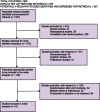Timing of administration of prophylactic antibiotics for caesarean section: a systematic review and meta-analysis
- PMID: 23126271
- PMCID: PMC3654161
- DOI: 10.1111/1471-0528.12036
Timing of administration of prophylactic antibiotics for caesarean section: a systematic review and meta-analysis
Abstract
Background: Prophylactic antibiotics reduce infectious morbidity from caesarean section. The timing of their administration, however, is a matter of controversy.
Objectives: To examine maternal and neonatal infectious morbidity in women receiving preoperative prophylaxis compared with those receiving intraoperative administration.
Search strategy: Medline, Embase, Current Controlled Trials and Cochrane Central were searched from their inception dates to December 2011.
Selection criteria: Randomised controlled trials of a single dose of any antibiotic comparing preoperative with intraoperative administration were selected.
Data collection and analysis: Trial characteristics, outcomes and quality measures, based on the Cochrane tool for risk of bias, were independently extracted. The random effect model of DerSimonian and Laird to estimate relative risks (RRs) for maternal and neonatal outcomes was used.
Main results: Six trials met the inclusion criteria, reporting on 2313 women and 2345 newborns. Preoperative administration was associated with a significant 41% reduction in the rate of endometritis compared with intraoperative administration (RR 0.59; 95% confidence interval [95% CI] 0.37-0.94; I2 0%). In the preoperative group, there were nonsignificant reductions in the rates of wound infection (RR 0.71; 95% CI 0.44-1.14; I2 0%), maternal febrile morbidity (RR 0.94; 95% CI 0.46-1.95; I2 0%), neonatal sepsis (RR 0.81; 95% CI 0.47-1.41; I2 0%), neonatal septic work-up (RR 0.93; 95% CI 0.71-1.21; I2 0%) and neonatal intensive-care unit admission (RR 0.92; 95% CI 0.65-1.28; I2 0%). There were nonsignificant increases in the rates of maternal pyelonephritis (RR 1.09; 95% CI 0.49-2.43; I2 0%) and neonatal pneumonia (RR 3.36; 95% CI 0.55-20.47; I2 0%).
Conclusions: Compared with intraoperative administration, preoperative antibiotics significantly reduce the rate of endometritis. The lack of neonatal adverse effects should be cautiously interpreted given the limited power of the trials to detect such effects.
© 2012 The Authors BJOG An International Journal of Obstetrics and Gynaecology © 2012 RCOG.
Figures
Comment in
-
Timing of antibiotic prophylaxis for caesarean section.BJOG. 2013 May;120(6):778. doi: 10.1111/1471-0528.12159. BJOG. 2013. PMID: 23565959 No abstract available.
-
Timing of antibiotic prophylaxis for caesarean section.BJOG. 2013 May;120(6):778-9. doi: 10.1111/1471-0528.12160. BJOG. 2013. PMID: 23565960 No abstract available.
-
A report from #BlueJC: Prophylactic antibiotics for caesarean section-before or after cord-clamping?BJOG. 2013 May;120(6):779-80. doi: 10.1111/1471-0528.12244. BJOG. 2013. PMID: 23565961 No abstract available.
-
Prophylactic antibiotics for caesarean section administered preoperatively rather than post cord clamping significantly reduces the rate of endometritis.Evid Based Med. 2014 Feb;19(1):17. doi: 10.1136/eb-2013-101429. Epub 2013 Jul 31. Evid Based Med. 2014. PMID: 23903591 No abstract available.
References
-
- Smaill F, Hofmeyr GJ. Antibiotic prophylaxis regimens and drugs for cesarean section. The Cochrane Database of Systematic Reviews. 1996;2(Issue 2) Art. No.:CD001136. DOI: 10.1002/14651858. - DOI - PubMed
-
- Hopkins L, Smaill F. Antibiotic prophylaxis regimens and drugs for cesarean section. The Cochrane Database of Systematic Reviews. 1999. Art. No.:CD001136. DOI: 10.1002/14651858. - DOI - PubMed
Publication types
MeSH terms
Substances
LinkOut - more resources
Full Text Sources
Medical
Miscellaneous




